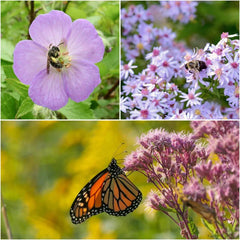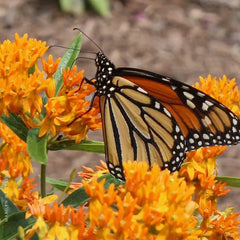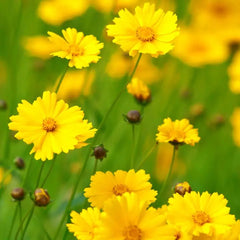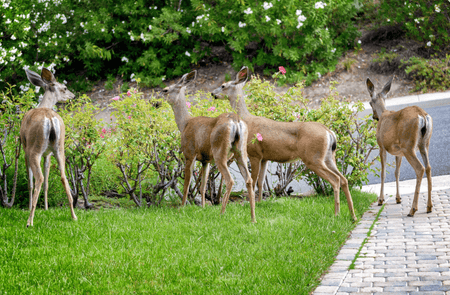How To: Help Birds with Native Plant Home Gardens in Fall and Winter

As the seasons change and the air turns crisper, our gardens transform into crucial refuges for our feathered friends. Fall and winter bring unique challenges for native birds, but with the right native plants, we can create nurturing havens that sustain these winged wonders.
We'll explore the world of native birds, their essential needs during the colder months, and how native wildflowers, grasses, shrubs, and trees can play a vital role in supporting their survival and well-being.

Fall and Winter Challenges for Native Birds
The fall and winter months pose various challenges for native birds. With temperatures dropping and food sources dwindling, birds face the need for shelter and sustenance. Fall and winter pose several challenges for native birds, which they must overcome to survive during these seasons. Some of the key challenges include:
Food Scarcity: Insects, a primary food source for many bird species and their young, become go dormant or die off in colder weather. This reduction in insect availability can impact birds' ability to find sufficient protein. By fall, native plants have produced all the fruits and seeds for the year, so this food supply dwindles as fall progresses into winter.
Cold Temperatures: As temperatures drop, birds must expend more energy to stay warm. Maintaining their body heat requires additional calories, making access to food crucial.
Migration: Some bird species migrate to warmer climates during the fall and stay there for the winter. Migration is a challenging and energy-intensive process that can be hazardous due to predators, weather conditions, and food availability.
Shortened Daylight Hours: With shorter daylight hours, birds have less time for foraging and feeding. They must efficiently locate and consume enough food during the limited daylight.
Lack of Shelter: Harsh weather conditions, including wind, rain, and snow, means birds need protective cover to stay dry and avoid exposure.
Water Sources: In freezing temperatures, natural water sources may freeze over, making it difficult for birds to access drinking and bathing water.
Lawns and Non-Native Plants - Landscapes dominated by lawns and non-native plants mean that less food resources are available to birds trying to migrate or survive the winter. We recommend you kill your lawn!
Human Impact: Human activities, such as habitat destruction, pollution, and collisions with buildings, can exacerbate the challenges birds face during fall and winter.
To help native birds overcome these challenges, home gardeners can create bird-friendly habitats by providing food, water, and places where bird can find cover from the elements in their gardens. Planting native species that produce berries and seeds, as well as providing bird feeders and heated birdbaths, can be particularly beneficial during these seasons.
Creating Bird Habitat in Fall and Winter
Evergreen Trees and Shrubs: Evergreens like eastern red cedar and American holly provide year-round cover, protecting birds from harsh weather and predators.
Native Grasses and Perennials: Native grasses and perennials offer shelter from wind and snow when planted in dense patches.
Beyond Flowers: Enhancing Wildlife Gardens with Native Grasses
Dead Wood: Dead and dying trees with hollows and cavities serve as important shelter for many birds. Fallen branches create brush piles where many species find cover.
Food Sources
Berry-Producing Plants: Berry-producing shrubs like serviceberry, elderberry, and holly provide a rich source of nutrition for birds. They are especially vital as other food options become scarce.
Best Native Berry Producing Shrubs: How to Attract More Wildlife to Your Garden
Seed-Producing Plants: Native plants like sunflowers, asters, and goldenrods produce seeds that sustain birds during the winter. Leaving seed heads intact can be a lifeline for them.
Nut-Producing Plants: Nuts from native trees such as oaks, hickories, beech and hazelnuts, and cones from pines, spruces and firs are an important food source throughout the cold months for birds ranging from woodpeckers to jays to wild turkey.
Insect-Friendly Plants: While we often associate birds with seeds, most species rely on insects for protein. Native plants support these insects, many of which overwinter in their stems or under the fallen leaves where birds forage for them throughout the fall and winter.
Water Features for Wildlife in Winter

Supporting birds during colder months with readily available water sources is a compassionate and beneficial practice. The challenge of ensuring your water doesn’t freeze is a conundrum for gardeners and wildlife enthusiasts alike.
Here are some water source ideas for your home or garden:
Heated Bird Baths: Invest in a heated bird bath that keeps water just above freezing so it remains available to birds. These come in various designs, including ground-level and pedestal styles.
Solar-Powered Fountains: Solar fountains with integrated heaters can create a visually appealing and functional water source for birds. The sounds of water attracts birds. The solar panel powers the pump and heating element.
Frequent Water Replacement: The easiest way to provide birds with water during freezing temperatures is to simply dump the ice out of your birdbath each morning and refill with cold water. Birds will appreciate having a chance to drink before the water freezes.
Remember to clean and refill the water source regularly to ensure it remains inviting and safe for birds. By offering them access to unfrozen water, you contribute to their health and survival during the challenging winter months, creating a welcoming oasis in your garden or home for our feathered friends.
Read: How to Use Water Features to Attract Wildlife
Other Ways to Support Fall Bird Migration
Safe Rest Stops: Create safe resting spots by planting native trees and shrubs that offer cover and perching opportunities. Birds often need a place to rest and refuel before continuing their journey.
Provide Deadwood and Snags: Leave some dead or decaying trees (snags) in your garden to attract insects and provide shelter for birds.
Natural Mulch: Use natural mulch like compost or fallen leaves to create a habitat for insects that birds feed on. Learn how to leave the leaves for wildlife!
Window Safety: Birds can collide with windows, especially during migration. Install window decals or screens to prevent these accidents and keep lights off at night when many bird species migrate.
Reduce Light Pollution: Excess artificial light can disorient migrating birds at night. Minimize outdoor lighting, especially during peak migration times.
Remember that many migratory birds are protected by law, so it's essential to respect their habitats and welfare. Your efforts, even on a small scale, can make a meaningful difference in ensuring the safety and well-being of native birds during their fall migration.
Types of Birds and How They Utilize Native Plants

- Seed Eaters, including sparrows, finches, juncos and doves, rely on seeds from native plants as their primary form sustenance throughout the fall and winter.
- Insect Eaters, such as the woodpeckers, nuthatches wrens and chickadees, search for insects beneath the bark of trees, especially during the winter when insects are less active. Dead or decaying trees, known as snags, provide excellent foraging spots.
- Berry Eaters like the American robin, eastern bluebird and northern mockingbird enjoy native berries like those from hollies and hawthorn bushes.
- Winter-Resident Birds rely on native plants for cover in fall and winter. Evergreen foliage offers great shelter for many species, while dense plantings of native grasses and perennials for others.
9 Native Plants for Wildlife in Winter
Supporting wildlife, especially birds, during the colder months is a noble endeavor, and native plants play a pivotal role in this effort. While they may not actively be in bloom during cold months, these plants provide essential food sources, shelter, and even nesting materials for birds. Here are some native plant species that are particularly beneficial to wildlife during the colder months:
Eastern Red Cedar (Juniperus virginiana): The blue, berry-like cones of the Eastern red cedar are a winter staple for birds like cedar waxwings, robins, and finches. These evergreen trees also provide valuable shelter from harsh weather.
American Holly (Ilex opaca): American holly's bright red berries persist through the winter, offering sustenance for various bird species, including thrushes and bluebirds.
Winterberry (Ilex verticillata, pictured above): Winterberry shrubs are known for their vibrant red berries that persist into the winter months, attracting birds such as American robins, northern mockingbirds, and cedar waxwings.
Chokeberry (Aronia spp)
Like winterberry, chokeberries produce berries that persist though the winter.
American Elderberry (Sambucus canadensis): Elderberry shrubs produce clusters of small, dark berries that are a valuable winter food source for birds like thrushes, grosbeaks, and catbirds.
Black-eyed Susan (Rudbeckia spp.)
The seeds of black-eyed Susan plants are a nutritious winter food for finches, sparrows, and other seed-eating birds.
Coneflowers (Echinacea spp.)
Coneflowers not only provide seeds for birds but also attract insects during the growing season, serving as a year-round resource.
Asters (Symphyotrichum spp.): Asters produce small seeds that attract finches, sparrows, and other small birds during the colder months.
Sunflowers (Helianthus spp.): Sunflowers are renowned for their abundant seeds, which are cherished by a wide range of birds, including cardinals, jays, and chickadees.
Goldenrods (Solidago spp.): Goldenrods provide seeds and shelter for birds during the winter, supporting species like sparrows and finches.By incorporating these native plants into your garden or landscape, you not only enhance its beauty but also create a vital haven for birds during the colder months. These plants offer sustenance, shelter, and a sense of continuity in the natural world, ensuring that our feathered friends thrive year-round.
Your native plant garden has the power to become a sanctuary for native birds during the fall and winter months. By selecting the right mix of native plants, including native wildflowers, grasses, shrubs, and trees, you not only support these feathered friends but also contribute to the overall health of your local ecosystem. A successful wildlife garden requires 5 things: food, water, cover, places to raise young, and sustainable gardening practices. If you have all that, you’re ready to become a National Wildlife Federation Certified Wildlife Habitat®.
As your garden comes to life with the sights and sounds of native birds, you'll experience the joy of being a steward of the environment and witness the magic of nature's interconnected web. With every bird's visit, you'll be reminded of the collective impact we can all have on our planet right at home.

Find Native Plants by Zip Code
We took the guesswork out of planting native. Check your zip to see what ships!























